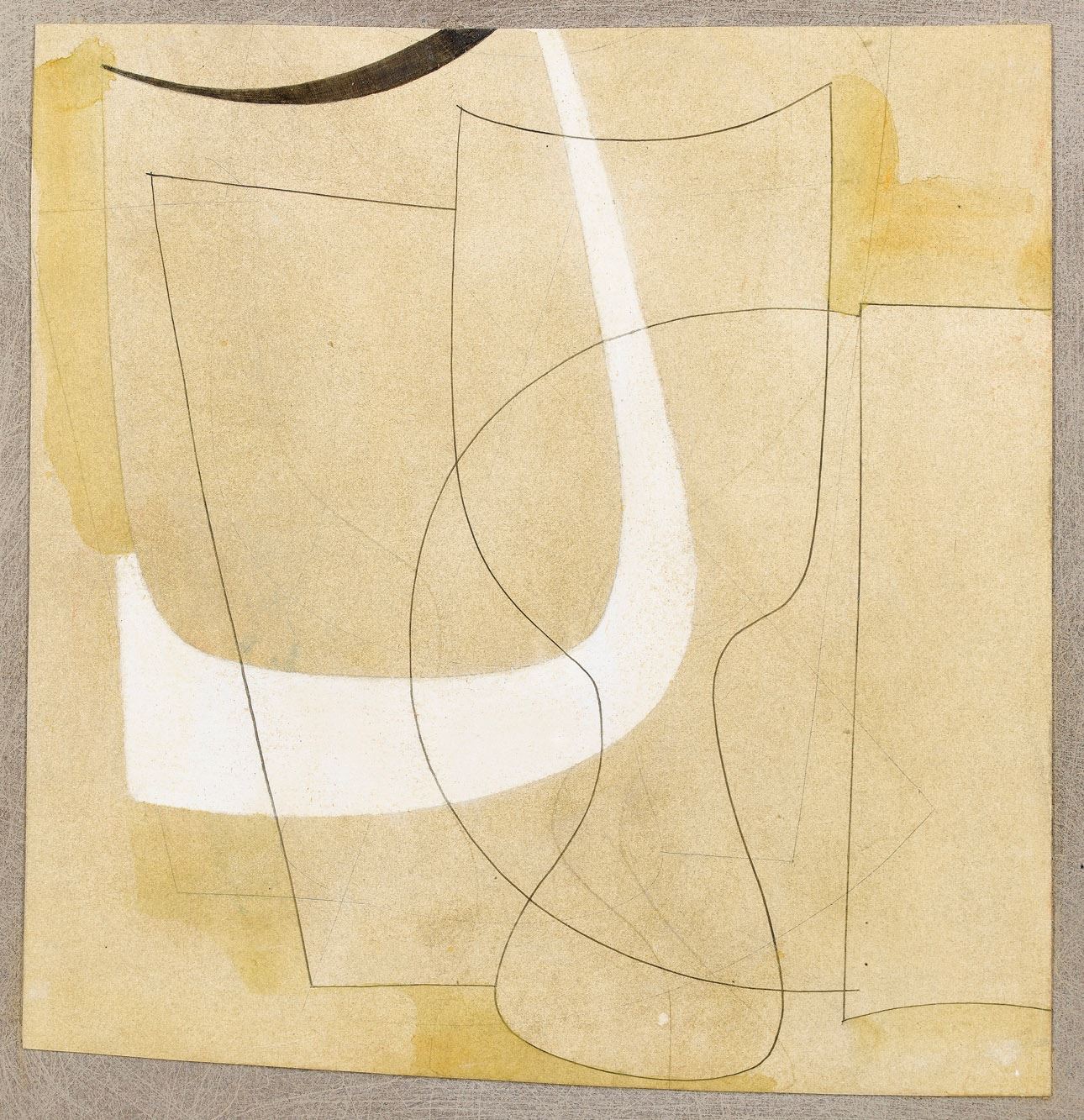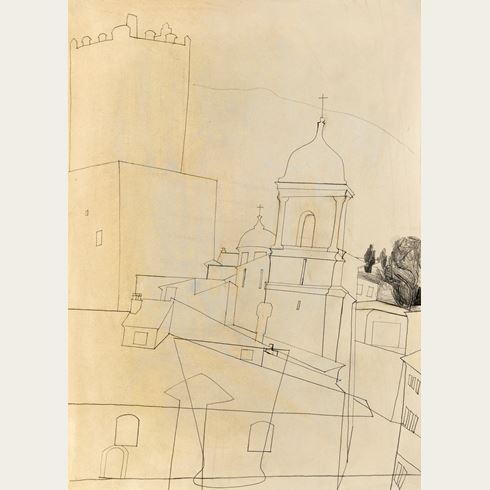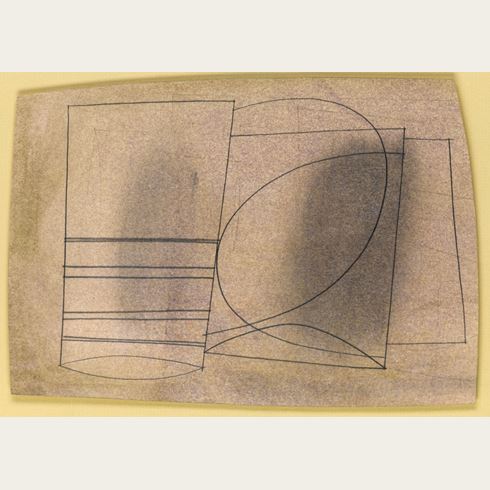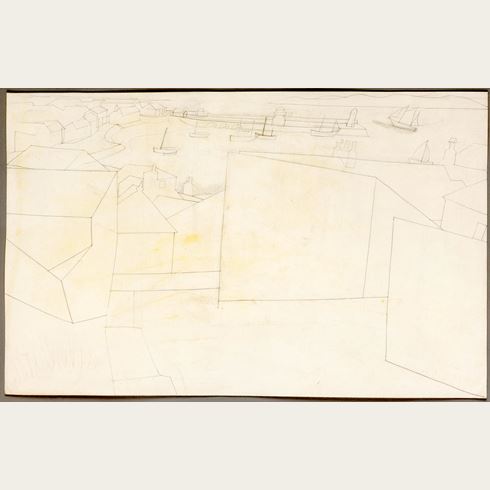Ben NICHOLSON
(Derham 1894 - London 1982)
March 1959 (white form)
Sold
Gouache, watercolour, pencil and pen and ink on card, mounted on the artist’s prepared etched grey board.
Signed and dated NICHOLSON / March 59 and inscribed (white form) on the reverse of the prepared board.
277 x 272 mm. (10 7/8 x 10 3/4 in.) at greatest dimensions [sheet]
378 x 374 mm. (14 7/8 x 14 3/4 in.) [board]
Signed and dated NICHOLSON / March 59 and inscribed (white form) on the reverse of the prepared board.
277 x 272 mm. (10 7/8 x 10 3/4 in.) at greatest dimensions [sheet]
378 x 374 mm. (14 7/8 x 14 3/4 in.) [board]
The present sheet, dated March 1959, was completed the year after Nicholson had settled in the canton of Ticino in southern Switzerland, where for the first months of his stay, he lived and worked in a small, two-room house. ‘With a real sense of starting afresh, he adapted to the lack of space and set about making the first of a spate of drawings – some two hundred over the next two years - all of them variations on familiar still-life objects…Throughout the 1940s and 1950s still life was a major theme in his paintings. Now he would explore its latent possibilities purely in terms of line…The line of a cup or a beaker extends in an abstract rhythm and plays against the free-flowing lines of a jug or goblet in one, seemingly continuous, movement…The shape of the spaces between objects is as important as the shape of the objects themselves, so that there is a teasing interchange between the two. Always Nicholson’s drawings bear the marks of their physical making, nothing is fudged or concealed, each line is to be appreciated for its qualities as a line as well as for its function of delineating.’ After moving into a larger house and studio in 1960, Nicholson began to concentrate on his painted reliefs, which occupied him for much of the following decade.
As one scholar has written, ‘The drawings and reliefs executed by Ben Nicholson between 1950 and 1975…stand as his most assured, most characteristic achievement, and, with the white reliefs of 1934-9, are the works by which he himself wished to be judged…The drawings have mistakenly been treated as somehow subsidiary to the paintings and reliefs when in fact they have qualities of wit, poetry and spontaneity quite special to themselves – qualities which, added to their variety and sheer virtuosity, entitle them to fully equal status…they are perhaps Nicholson’s most personal expressions.’
As one scholar has written, ‘The drawings and reliefs executed by Ben Nicholson between 1950 and 1975…stand as his most assured, most characteristic achievement, and, with the white reliefs of 1934-9, are the works by which he himself wished to be judged…The drawings have mistakenly been treated as somehow subsidiary to the paintings and reliefs when in fact they have qualities of wit, poetry and spontaneity quite special to themselves – qualities which, added to their variety and sheer virtuosity, entitle them to fully equal status…they are perhaps Nicholson’s most personal expressions.’
The son of the painters William Nicholson and Mabel Pryde, Ben Nicholson spent a brief period at the Slade School of Art in London but was otherwise without formal artistic training. It was not until 1920 and his marriage to the painter Winifred Dacre that he began to paint seriously, producing mainly still life and landscape paintings throughout the following decade. In 1932 he and his second wife, Barbara Hepworth, traveled to France and there met and befriended Pablo Picasso, Georges Braque, Constantin Brancusi and Jean Arp, and later Piet Mondrian. It was also at this time, in the 1930’s, that Nicholson began to work in a more Cubist manner, creating paintings and reliefs made up of abstract geometrical forms, and in particular producing a series of carved and painted white reliefs that have become icons of 20th century English modernism. At the outbreak of the Second World War, Nicholson and Hepworth and their children moved to the town of St. Ives in Cornwall, where they became the nucleus of a vibrant artistic community. Nicholson’s reputation grew significantly after the war, and he won several artistic prizes in America and elsewhere. In 1954 a retrospective exhibition of his work was held in the British pavilion at the Venice Biennale, followed a year later by one at the Tate. In 1958 he left St. Ives and settled in Switzerland, having annulled his marriage to Hepworth in 1951 and remarried. A second Tate retrospective in 1968 was accompanied by the awarding of the Order of Merit.
Drawing was an important part of Nicholson’s artistic process throughout his career. His drawings were, however, not made as studies for carved reliefs or paintings, and it should be noted that ‘more than simply preparatory or exploratory tools, drawings were to him full-blown works of art…His drawings are characterized by a strong continuous line, which sinuously defines form and space without a break. Shading is used sparingly and any illusion of volumetric mass simply suggested by the interweaving lines.’
Provenance
Durlacher Brothers, New York
Acquired from them in November 1959 by I.A.L. and Barbara Diamond, Los Angeles
Thence by descent until 2008.







